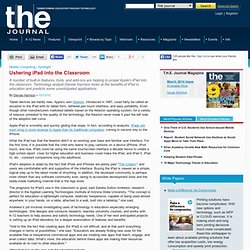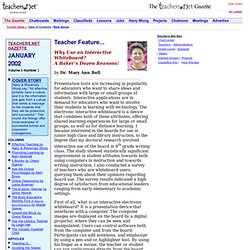

Integrating Technology into the Language Arts Classroom, Teaching Today. Literacy & Technology Integration at The Literacy Web. Using Technology to Enhance Literacy Instruction. This Critical Issue was coauthored by Ann Holum, Ph.D., and Jan Gahala, M.A.

Holum's doctoral work on the use of interactive media to improve children's story-understanding skills sparked her ongoing interest in integrating technologies in K-12 literacy settings; she currently is an independent educational consultant. Gahala is a technical specialist in NCREL's Communications department. ISSUE: Educational technology is nudging literacy instruction beyond its oral and print-based tradition to embrace online and electronic texts as well as multimedia. Computers are creating new opportunities for writing and collaborating. The Internet is constructing global bridges for students to communicate, underscoring the need for rock-solid reading and writing skills.
Although technology promises new ways to promote literacy, educators' reactions to it have been mixed. Overview | Goals | Action Options | Pitfalls | Different Viewpoints | Cases | Contacts | References Edyth E. Effects of Technology on Classrooms and Students. A r c h i v e d I n f o r m a t i o n Change inStudent andTeacherRoles When students are using technology as a tool or a support for communicating with others, they are in an active role rather than the passive role of recipient of information transmitted by a teacher, textbook, or broadcast. The student is actively making choices about how to generate, obtain, manipulate, or display information.
Technology use allows many more students to be actively thinking about information, making choices, and executing skills than is typical in teacher-led lessons. Moreover, when technology is used as a tool to support students in performing authentic tasks, the students are in the position of defining their goals, making design decisions, and evaluating their progress. The teacher's role changes as well. Project-based work (such as the City Building Project and the Student-Run Manufacturing Company) and cooperative learning approaches prompt this change in roles, whether technology is used or not. Ushering iPad into the Classroom. Mobile Computing | Spotlight Ushering iPad into the Classroom A number of built-in features, tools, and add-ons are helping to propel Apple's iPad into the classroom.

Technology analyst Denise Harrison looks at the benefits of iPad in education and predicts some unanticipated applications Tablet devices are hardly new; Apple's own Newton, introduced in 1987, could fairly be called an ancestor to the iPad with its tablet form, tethered pen touch interface, and easy portability. Even though other manufacturers marketed tablets based on the Newton operating system, for a variety of reasons unrelated to the quality of the technology, the Newton never made it past the left side of the adoption bell curve.
Apple iPad is smoothly and quickly gliding that slope. What the iPad has that the Newton didn't is an existing user base and familiar user interface. Andrews's job involves investigating uses of technology in education--especially emerging technologies. 10 Tips for Teachers Using Evernote – Education Series. Posted by Michael Cruz on 13 Jan 2011 Comment Michael Cruz is a great example of someone that has fully embraced the benefits of putting technology to use in a classroom setting.

For five years, he taught courses at San Jose State University’s College of Business ranging from web marketing to entrepreneurship. He now focuses on technology and productivity. Evernote is a great application for educators. As a teacher, my Evernote use falls into three categories: Prior to classDuring classAfter class Prior to class Plan and organize your classes with tags: Using tags is a great way to organize your classes on a week-to-week basis or on a class-by-class basis. During Class Share a notebook with your class: After you create a public notebook, share the URL with your class.
After Class Simplify grading: Scan graded tests, including scantrons and add them to Evernote. To get more productivity tips for teachers you can visit my website and sign up for my e-mail list. Evernote Education Series. Types Of Assistive Technology Devices. Family Center on Technology and Disability (FCTD) - Assistive Technology Works! GAZETTE - Teachers.Net Gazette provides news from Teachers.Net direct to teachers around the world. Teachers.Net features 24 hour discussions with teachers around the globe. Early childhood chatboard primary elementary chatboard upper element. Teacher Feature...

Why Use an Interactive Whiteboard? A Baker’s Dozen Reasons! By Dr. Mary Ann Bell Presentation tools are increasing in popularity for educators who want to share ideas and information with large or small groups of students. First of all, what is an interactive electronic whiteboard? Why do I like interactive whiteboards so much? The interactive electronic whiteboard is great for demonstrations.